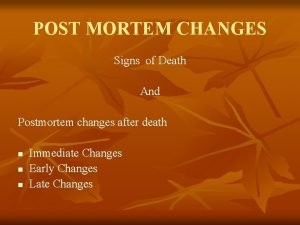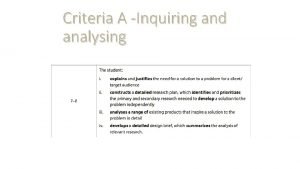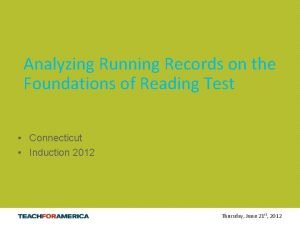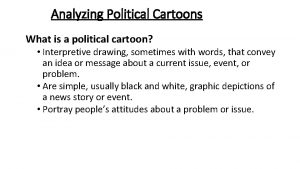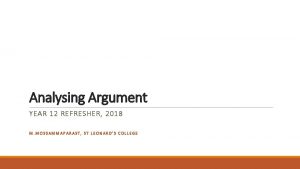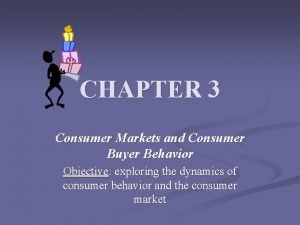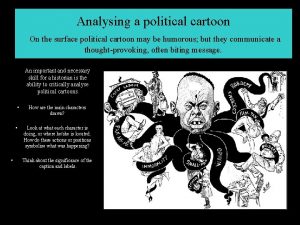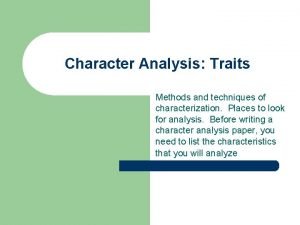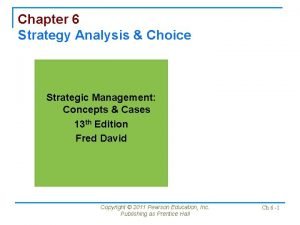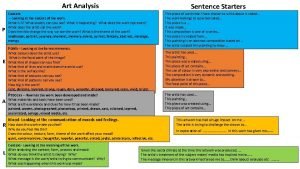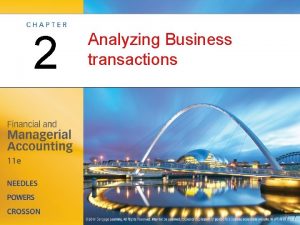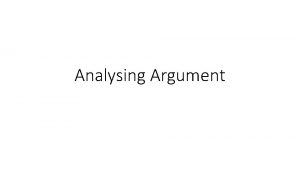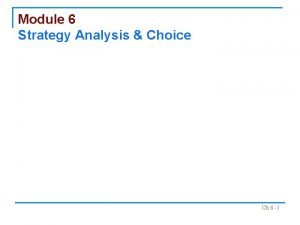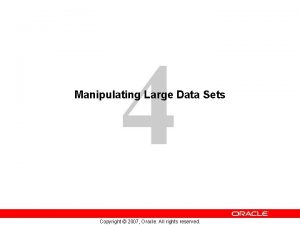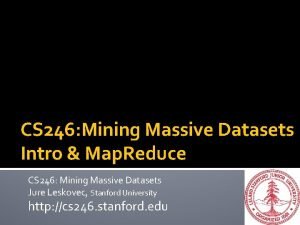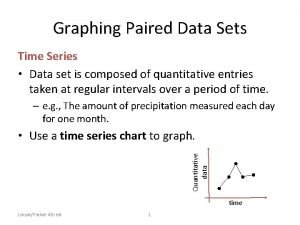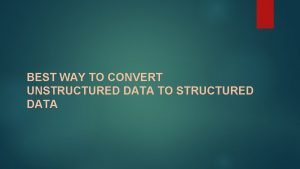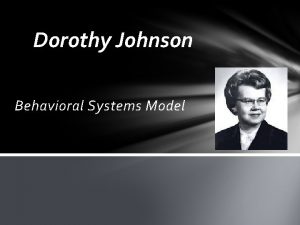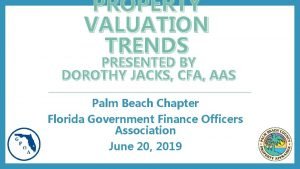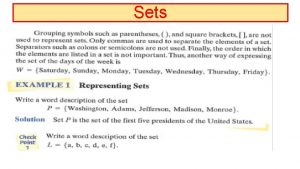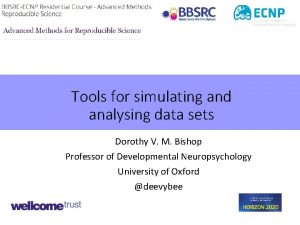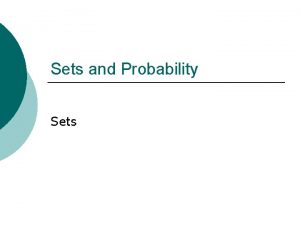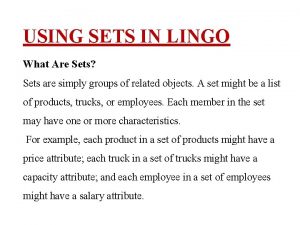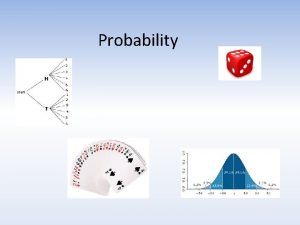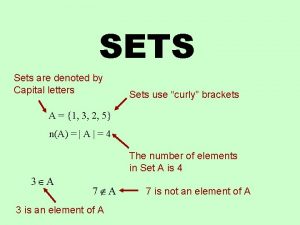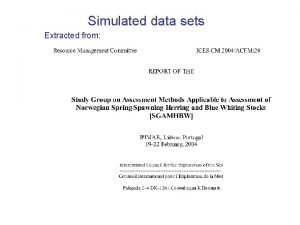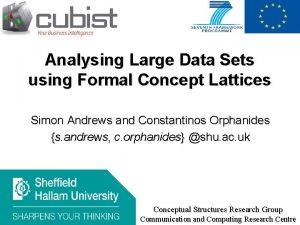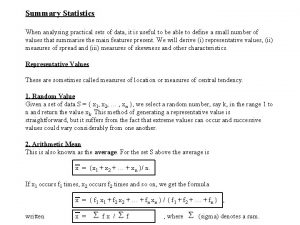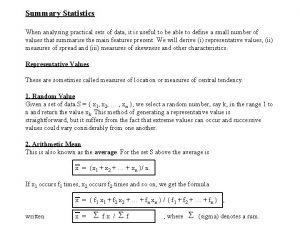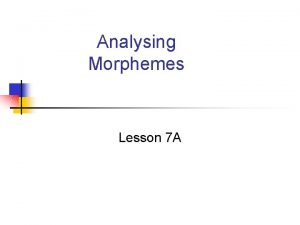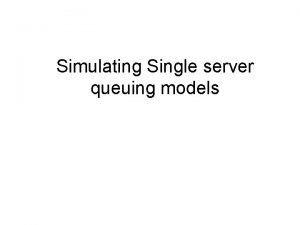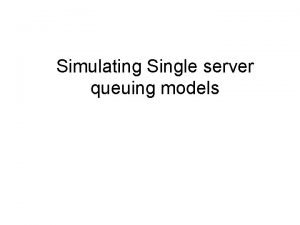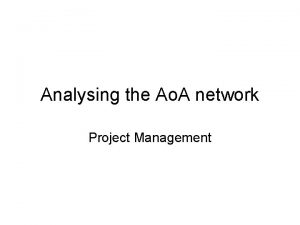Tools for simulating and analysing data sets Dorothy





























- Slides: 29

Tools for simulating and analysing data sets Dorothy V. M. Bishop Professor of Developmental Neuropsychology University of Oxford @deevybee

Suggested format of session • 9. 00 – 9. 30: Introduction to p-hacking, data dredging, and HARKing • 9. 30 -10. 30 Getting started with simulations in R. Everyone tries one or more of the scripts listed on the next slide – big range of difficulty • Those familiar with R pair up if possible with R newbies • 10. 45 -11. 00 We reconvene to discuss what we’ve learned and gather suggestions for new simulations – preferably based on studies you have done or have planned • 11. 00 -11. 30 Coffee • 11. 30 -12. 30 Further exercises with simulation scripts

Why invent data? • If you can anticipate what your data will look like, you will also anticipate a lot of issues about study design that you might not have thought of • Analysing a simulated dataset can give huge insights into what is optimal analysis/ how the analysis works • Simulated data very useful for power analysis – deciding what sample size to use

The four horsemen of the Apocalypse HARKing Low power P-hacking Publication bias

P-hacking and HARKing

You run a study investigating how a drug, X, affects anxiety. 1 0. 8 Improvement 0. 6 0. 4 0. 2 0 -0. 2 -0. 4 -0. 6 -0. 8 -1 0 5 10 15 Subject ID 20 25 Overall symptom improvement does not differ from zero 30

You look for possible moderators – sex, age, SES. When you plot the results by age, you see this: Treatment effect by age Symptom improvement 1 0. 8 0. 6 0. 4 0. 2 0 -0. 2 -0. 4 -0. 6 -0. 8 -1 16 20 24 28 32 36 40 Age (yr) 44 48 52 Age x treatment effect, p <. 05 Significant improvement in those aged over 36!! 56 60 P-Hacking

How should you analyse/report this result? Treatment effect by age Symptom improvement 1 0. 8 0. 6 0. 4 0. 2 0 -0. 2 -0. 4 -0. 6 -0. 8 -1 16 20 24 28 32 36 40 Age (yr) 44 48 52 56 60 • Report that you tested whether X affects anxiety • Report that you tested whether age affects the impact of X on anxiety • Remove data from those aged under 36 as it is not interesting

Close link between p-hacking and HARKing Symptom improvement Treatment effect by age 1 0. 5 0 -0. 5 -1 16 20 24 28 32 36 40 Age (yr) 44 48 52 56 60 You are HARKing if you have no prior predictions, but on seeing results you write up paper as if you planned to look at effect of age on drug effect. This kind of thing is endemic in psychology. • It is OK to say that this association was observed in exploratory analysis, and that it suggests a new hypothesis that needs to be tested in a new sample. • It is NOT OK to pretend that you predicted the association if you didn’t. • And it is REALLY NOT OK to report only the data that support your new hypothesis (i. e. removing variables/subjects)

Historical timeline: concerns about reproducibility 1956 De Groot Failure to distinguish between hypothesis-testing and hypothesis-generating (exploratory) research -> misuse of statistical tests Acta Psychologica 148, 2014, pp. 188 -194 The meaning of “significance” for different types of research [translated annotated by Eric-Jan Wagenmakers et al. //doi. org/10. 1016/j. actpsy. 2014. 02. 001

Key question: Did researcher specifically predict this association?

P-hacking -> huge risk of false positives


Writing the Empirical Journal Article Daryl J. Bem Explicitly advises HARKing! The Compleat Academic: A Practical Guide for the Beginning Social Scientist, 2 nd Edition. Washington, DC: American Psychological Association, 2004. Which Article Should You Write? There are two possible articles you can write: (a) the article you planned to write when you designed your study or (b) the article that makes the most sense now that you have seen the results. They are rarely the same, and the correct answer is (b). re Data Analysis: Examine them from every angle. Analyze the sexes separately. Make up new composite indexes. If a datum suggests a new hypothesis, try to find additional evidence for it elsewhere in the data. If you see dim traces of interesting patterns, try to reorganize the data to bring them into bolder relief. If there are participants you don’t like, or trials, observers, or interviewers who gave you anomalous results, drop them (temporarily). Go on a fishing expedition for something— anything —interesting. “This book provides invaluable guidance that will help new academics plan, play, and ultimately win the academic career game. ”

One solution to protect against HARKing: Suggested wording in write-up to keep researchers honest ‘We report how we determined our sample size, all data exclusions (if any), all manipulations, and all measures in the study. ’ Simmons, J. P. , Nelson, L. D. , & Simonsohn, U. (2012). A 21 Word Solution. SPSP Dialogue, 26, 2, Fall 2012 issue.

Using simulated datasets to give insight into statistical methods https: //www. slideshare. net/deevybishop/introduction-to-simulating-data-toimprove-your-research

• Simulations help us understand problems of multiple testing, i. e. how you can get a ‘significant’ result from random data • Simulations are also useful for the opposite situation: showing how often you can fail to get a significant p-value, even when there is a true effect • This brings us on to the topic of statistical power (covered by Stan Lazic on Thursday)

Basic idea • Anything you measure has an effect of interest plus random noise • The goal of research is to find out • (a) whethere is an effect of interest • (b) if yes, how big it is • Classic hypothesis-testing with p-values is simply focuses just on (a) – i. e. have we just got noise or a real effect? • We can simulate most scenarios by generating random noise, with or without a consistent added effect

Repeated sampling from simulated data allows you to see how statistics vary with the play of chance • See Geoff Cumming: Dance of the p-values • https: //www. youtube. com/watch? v=5 OL 1 Rq. Hr. ZQ 8

Key point: p-values can only be interpreted in terms of the context in which they are computed Importance of p <. 05 makes sense only in relation to an a-priori hypothesis Many ways in which ‘hidden multiplicity’ of testing can give false positive (p <. 05) results • Data dredging from a large set of variables • Trying various analytic approaches until one ‘works’ • Multi-way Anova with many main effects/interactions • Post-hoc division of data into subgroups

Getting started in R • Important to set your working directory – place where R will look for files to read and will save files unless told otherwise. • `Can do this with command setwd() Mac example: setwd (“/Users/dbishop/Dropbox/repcourse”) PC example: setwd("C: \Users\dorothybishop\Dropbox\repcourse") Easier way in R studio: Session | Set Working Directory • Commands require() and library() are equivalent: they load packages you will need. • Packages need to be installed first; easy way to do this is via Tools|Install Packages. Only need to do that once

Getting started in R (ctd) • General rule #1: if you don't understand something, Google it! • General rule #2: You learn most when something doesn’t work and you have to work out why • General rule #3: you can learn a lot by tweaking a line of script to see what happens, but always make a copy of the original working script first. • If script doesn’t work, scroll back in Console to first (red) error message • When you select Run in taskbar, it only runs highlighted text (cf. Matlab). This means you can work through script line by line to see what it does This won’t, however work for a line that ends in ‘{‘ as script will pause to wait for ‘}’

R scripts available on : https: //osf. io/gupxv/ Simulation_ex 1_intro. R Suitable for R newbies. Demonstrates ‘dance of the p-values’ in a t-test. Bonus, you learn to make pirate plots Simulation_ex 1_multioutput. R takes same basic idea but uses loops to run multiple times. • Simulation_ex 2_correlations Generate correlation matrices from multivariate normal distribution. Bonus, you learn to use ‘grid’ to make nicely formatted tabular outputs. • Simulation_ex 3_multiway. Anova. R Simulate data for a 3 -way mixed ANOVA. Demonstrates need to correct for N factors and interactions when doing exploratory multiway Anova. • Simulation_ex 4_multiple. Reg. R Simulate data for multiple regression. • Simulation_ex 5_falsediscovery. R Simulate data for mixture of null and true effects, to demonstrate that the probability of the data given the hypothesis is different from the probability of the hypothesis given the data. Now even more: See OSF! Two simulations from Daniel Lakens’ Coursera Course – with notes! • 1. 1 Which. Pvalues. Can. You. Expect. R; 3. 2 Optional. Stopping. Sim. R •


Correlation matrix for run 1 Output from simulation of 7 independent variables, where true correlation = 0 N = 30 Red denotes p <. 05 ( r >. 31 or < -. 31);

Correlation matrix for run 2 Output from simulation of 7 independent variables, where true correlation = 0 N = 30 Red denotes p <. 05 ( r >. 31 or < -. 31);

Correlation matrix for run 3 Output from simulation of 7 independent variables, where true correlation = 0 N = 30 Red denotes p <. 05 ( r >. 31 or < -. 31); There is no relation between variables – why do we have significant values?

Correlation matrix for run 4 Output from simulation of 7 independent variables, where true correlation = 0 N = 30 Red denotes p <. 05 ( r >. 31 or < -. 31); Bonferroni corrected p-value is. 05/21 =. 002, corresponds to r =. 51

10 runs of simulation with N = 20 per group and effect size (d) =. 3 * * **
 Analysing market data
Analysing market data Conditions simulating rigor mortis
Conditions simulating rigor mortis Conditions simulating rigor mortis
Conditions simulating rigor mortis Inquiring and analysing
Inquiring and analysing Running record codes
Running record codes Rough sailing ahead political cartoon answer key
Rough sailing ahead political cartoon answer key Argument analysis structure
Argument analysis structure The buying process starts when the buyer recognizes a
The buying process starts when the buyer recognizes a The chinese pest cartoon
The chinese pest cartoon Methods of characterization
Methods of characterization Strategy formulation analytical framework
Strategy formulation analytical framework Analysing sentence starters
Analysing sentence starters Analysing business transactions
Analysing business transactions Strategy analysis and choice largely involves making
Strategy analysis and choice largely involves making Analysing argument
Analysing argument Analysing the 6 strategic options megxit
Analysing the 6 strategic options megxit Dorothy f schmidt college of arts and letters
Dorothy f schmidt college of arts and letters Manipulating large data sets
Manipulating large data sets Mining of massive datasets stanford
Mining of massive datasets stanford Divide data sets in fourths
Divide data sets in fourths Paired data sets
Paired data sets Unstructured to structured data conversion
Unstructured to structured data conversion Joshua marshman
Joshua marshman Dorothy irene wiley
Dorothy irene wiley Dorothy stringer term dates
Dorothy stringer term dates Dorothy johnson theory example
Dorothy johnson theory example Dorothy height sorority
Dorothy height sorority A telephone call by dorothy parker
A telephone call by dorothy parker Dorothea puente serial killer
Dorothea puente serial killer Dorothy jacks cfa aas
Dorothy jacks cfa aas


